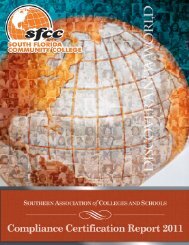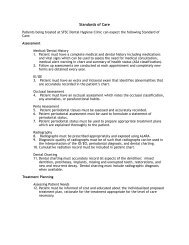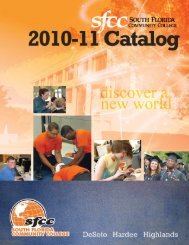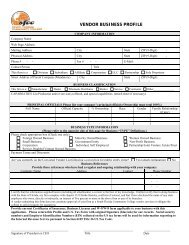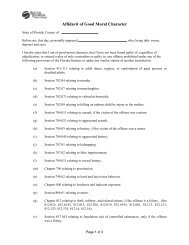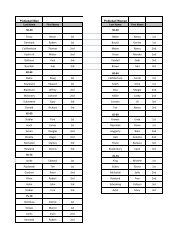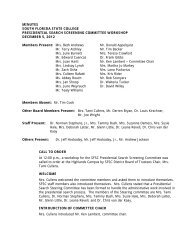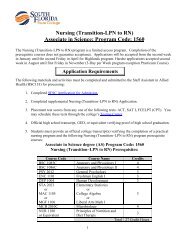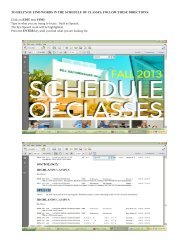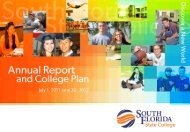2006-07 College Catalog - South Florida State College
2006-07 College Catalog - South Florida State College
2006-07 College Catalog - South Florida State College
- No tags were found...
Create successful ePaper yourself
Turn your PDF publications into a flip-book with our unique Google optimized e-Paper software.
5HWXUQWR6HFWLRQ0HQXStudents are required to learn and demonstrate the followingCLAST skills:COMMUNICATION SKILLSReading Skills:1. Recognize main ideas in a given passage.2. Identify supporting details.3. Determine meaning of words on the basis of context.4. Recognize the author’s purpose.5. Identify the author’s overall organizational pattern.6. Distinguish between statement of fact and statement ofopinion.7. Detect bias.8. Recognize author’s tone.9. Recognize explicit and implicit relationships within sentences.10. Recognize explicit and implicit relationships between sentences.11. Recognize valid arguments.12. Draw logical inferences and conclusions.Listening Skills: (Not yet tested on CLAST)13. Recognize main ideas.14. Identify supporting details.15. Recognize explicit relationships among ideas.16. Recall basic ideas and details.17. Perceive the speaker’s purpose.18. Discriminate between statements of fact and statementsof opinion.19. Distinguish between emotional and logical arguments.20. Detect bias.21. Recognize the speaker’s attitude.22. Synthesize by drawing logical inferences and conclusions.23. Evaluate objectively by drawing logical inferences and conclusions.24. Recall the arguments and identify the implications.English Language and Writing Skills (Combined):25. Select a subject which lends itself to development.26. Determine the purpose and the audience for writing.27. Limit the subject to a topic that can be developed within therequirements of time, purpose, and audience.28. Formulate a thesis or main idea statement that focuses onthe essay.29. Develop the thesis or main idea statement by providingadequate support that reflects the ability to distinguish betweengeneralized and specific evidence.30. Develop the thesis or main idea statement by arranging themain ideas and supporting details in a logical pattern appropriateto the purpose and focus.31. Develop the thesis or main idea statement by writing unifiedprose in which all supporting material is relevant to thethesis or main idea statement.32. Develop the thesis or main idea statement by writing coherentprose, and providing effective transitional devices whichclearly reflect the organizational pattern and the relationshipsof the parts.33. Demonstrate effective word choice by using words thatconvey the denotative and connotative meanings requiredby context.34. Demonstrate effective word choice by avoiding inappropriateuse of slang, jargon, clichés, and pretentious expressions.35. Demonstrate effective word choice by avoiding wordiness.36. Employ conventional sentence structure by placing modifierscorrectly.37. Employ conventional sentence structure by coordinatingand subordinating sentence elements according to theirrelative importance.38. Employ conventional sentence structure by using parallelexpressions for parallel ideas.39. Employ conventional sentence structure by avoiding fragments,comma splices, and fused sentences.40. Employ effective sentence structure by using a variety ofsentence patterns.41. Employ effective sentence structure by avoiding overuseof passive constructions.42. Observe the conventions of standard American Englishgrammar and usage by using standard verb forms.43. Observe the conventions of standard American Englishgrammar and usage by maintaining agreement betweensubject and verb, pronoun and antecedent.44. Observe the conventions of standard American Englishgrammar and usage by avoiding inappropriate shifts in tense.45. Observe the conventions of standard American Englishgrammar and usage by using proper case forms.46. Observe the conventions of standard American Englishgrammar and usage by maintaining a consistent point ofview.47. Observe the conventions of standard American Englishgrammar and usage by using adjectives and adverbs correctly.48. Observe the conventions of standard American Englishgrammar and usage by making logical comparisons.49. Use standard practice for spelling, punctuation, and capitalization.50. Revise, edit, and proofread units of discourse to ensureclarity, consistency, and conformity to the convention ofstandard written American English.Speaking Skills: (Not yet tested on CLAST)51. Determine the purpose of the oral discourse.52. Choose a topic and restrict it according to purpose andaudience.53. Fulfill the purpose by formulating the thesis or main-ideastatement.54. Fulfill the purpose by providing adequate support material.55. Fulfill the purpose by organizing suitably.56. Fulfill the purpose by using appropriate words.57. Fulfill the purpose by using effective transitions.58. Employ vocal variety in rate, pitch, and intensity.59. Articulate clearly.60. Employ the level of American English appropriate to thedesignated audience.61. Demonstrate nonverbal behavior which supports the verbalmessage with eye contact and appropriate posture,gestures, facial expression, and body movement.MATHEMATICS SKILLSArithmetic Skills:62. Add, subtract, multiply, and divide rational numbers.63. Add, subtract, multiply, and divide rational numbers in decimalform.64. Calculate percent increase and percent decrease.65. Solve the sentence “a % of b is c,” where values for two ofthe variables are given.66. Recognize the meaning of exponents.67. Recognize the role of the base number in determining placevalue in the base-ten numeration system.68. Identify equivalent forms of positive rational numbers involvingdecimals, percents, and fractions.69. Determine the order relation between real numbers.72



